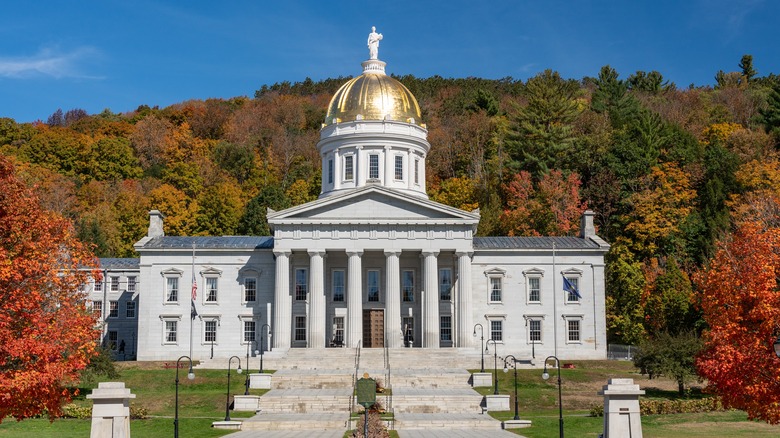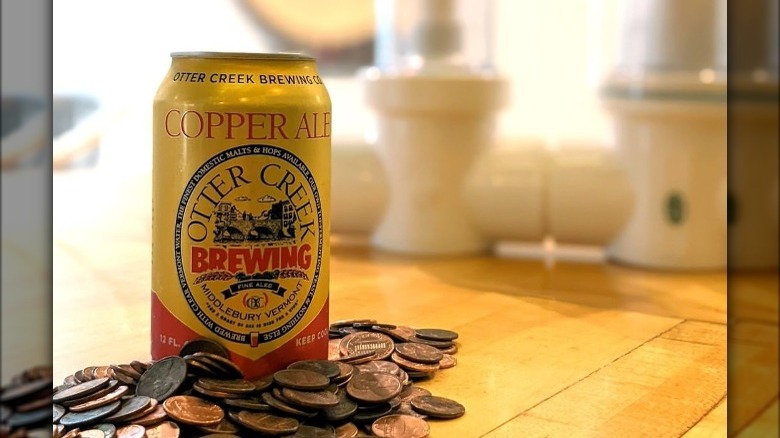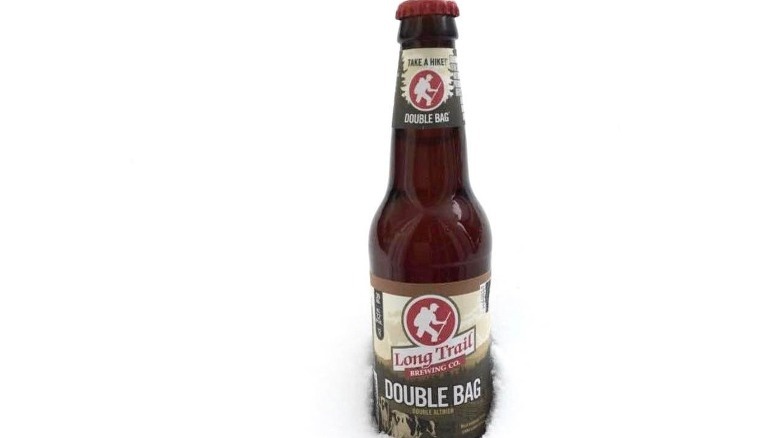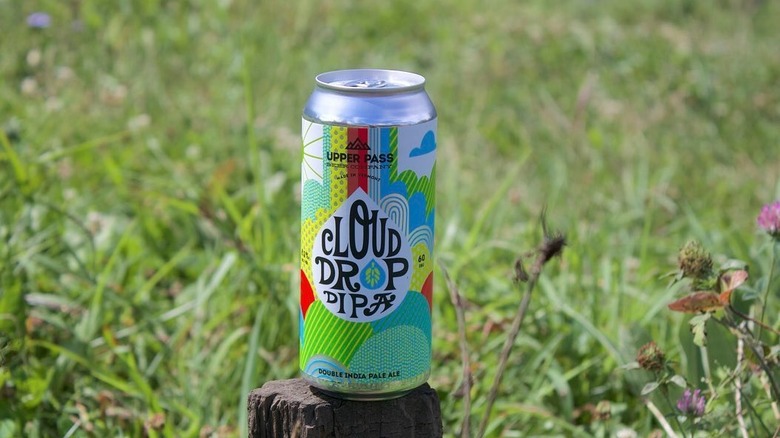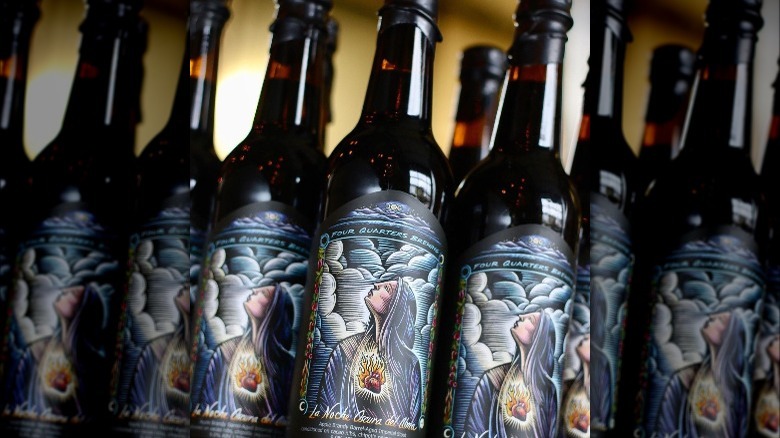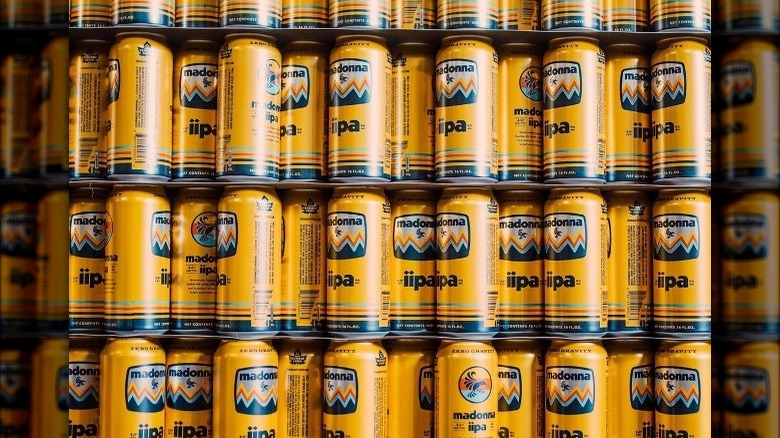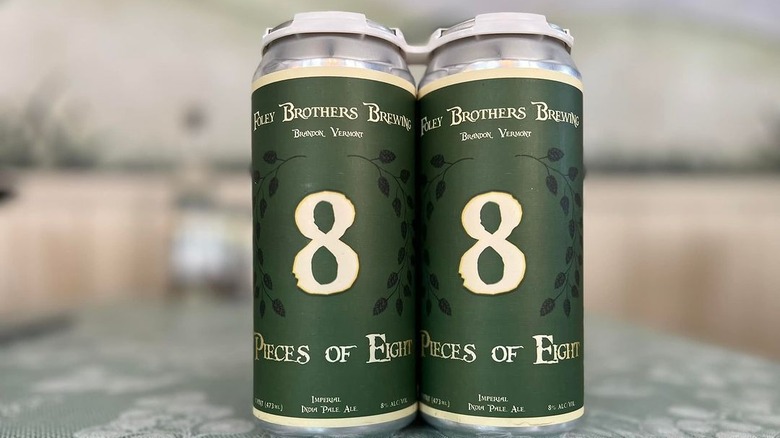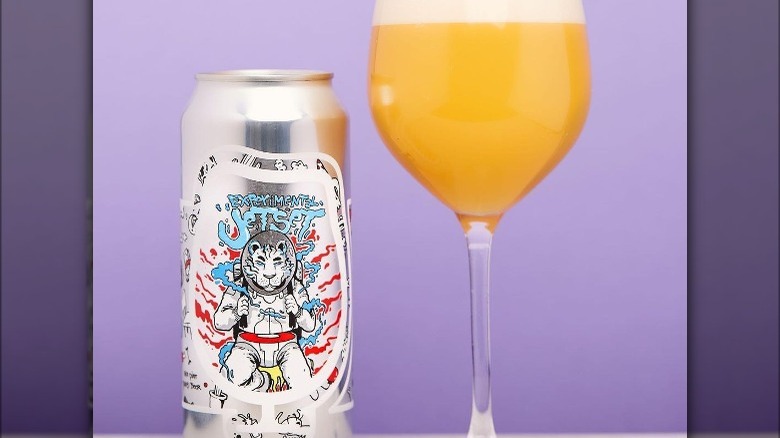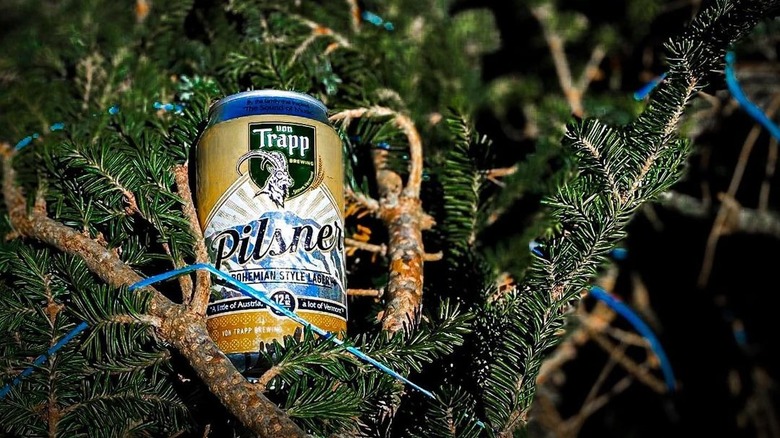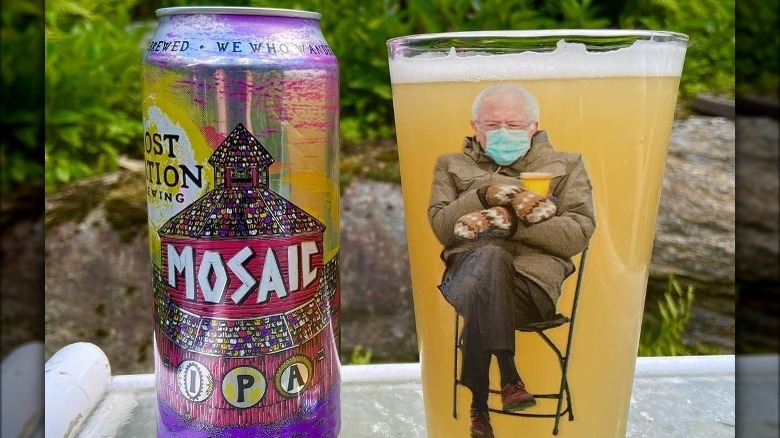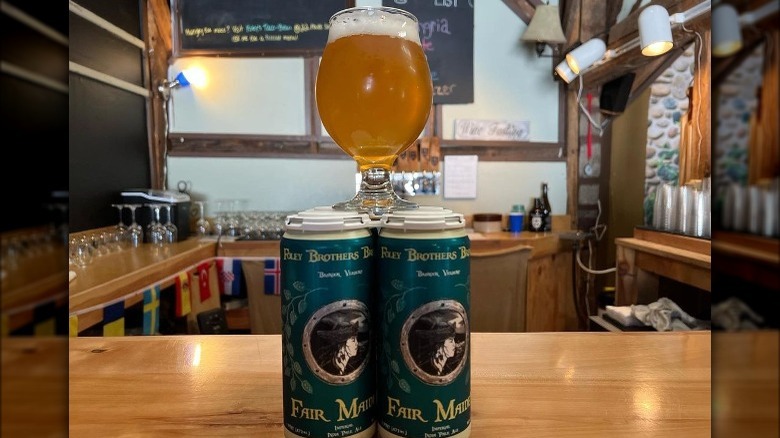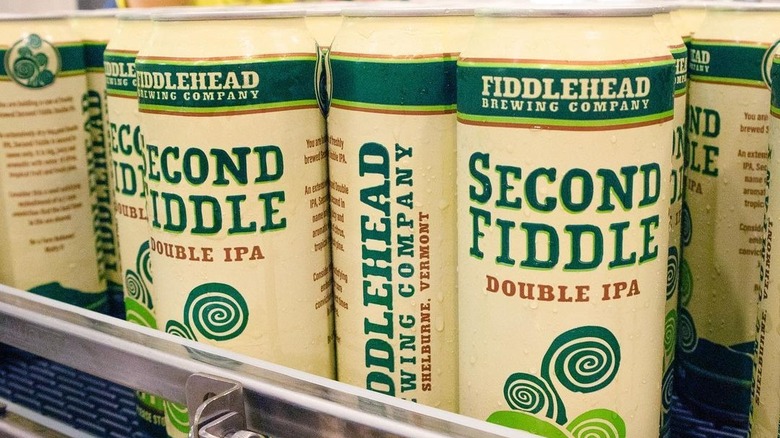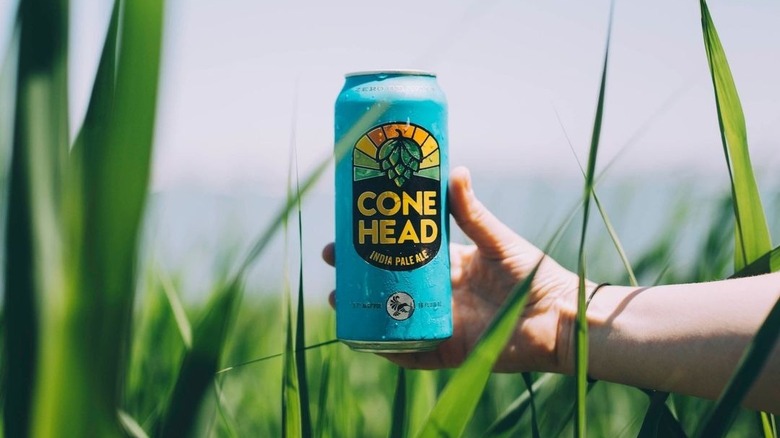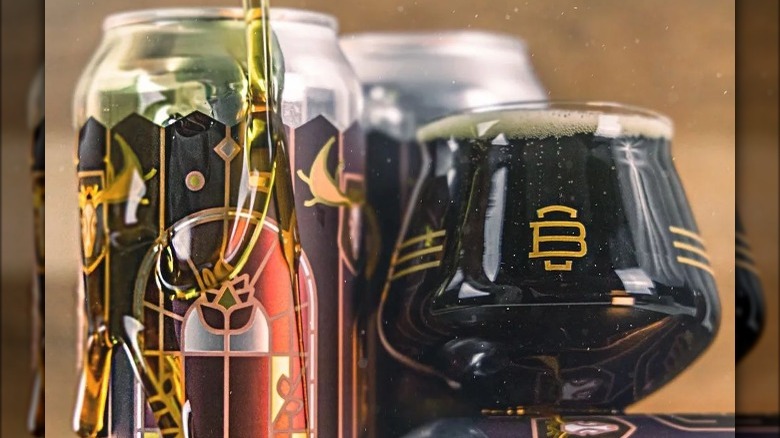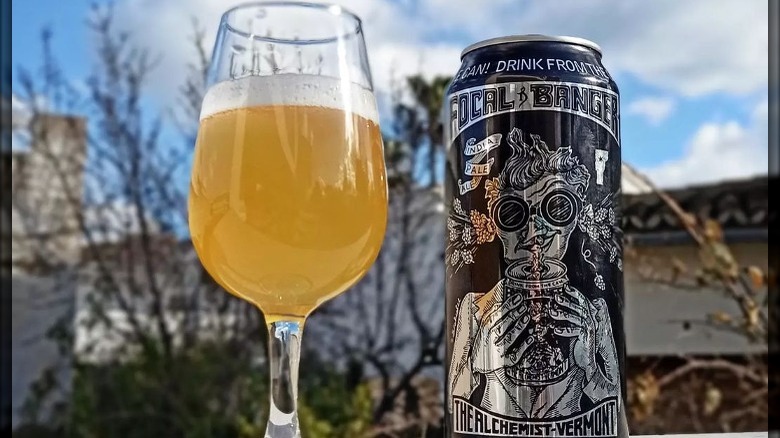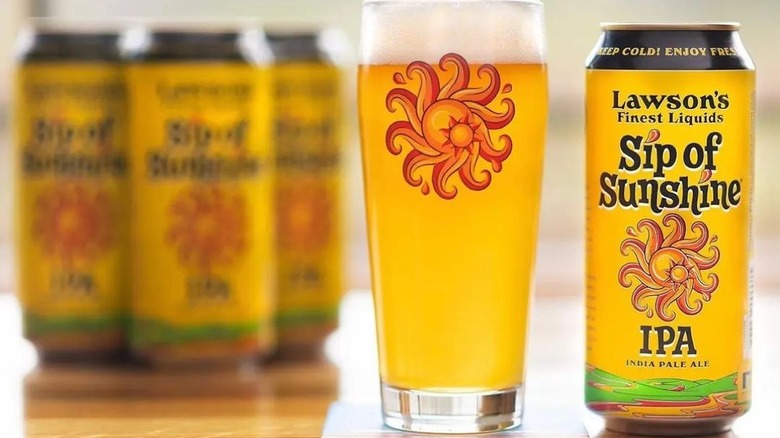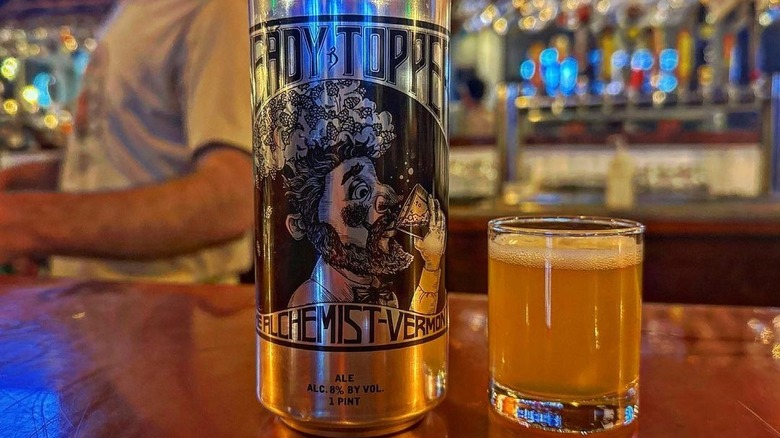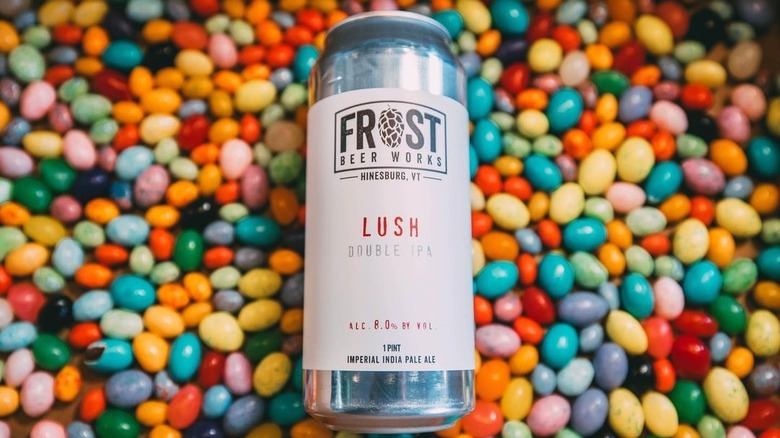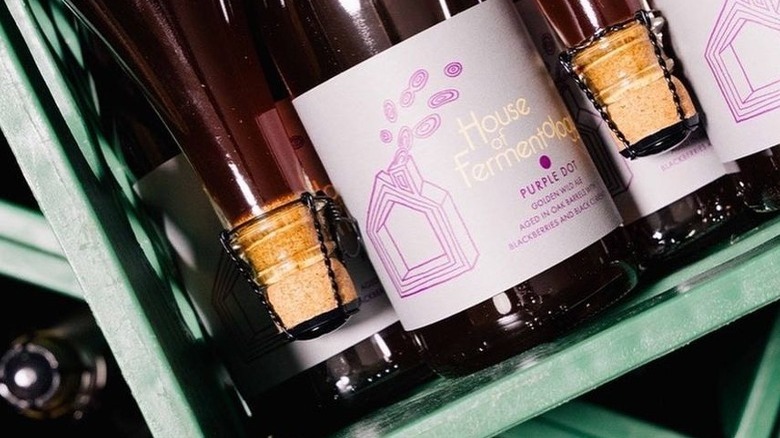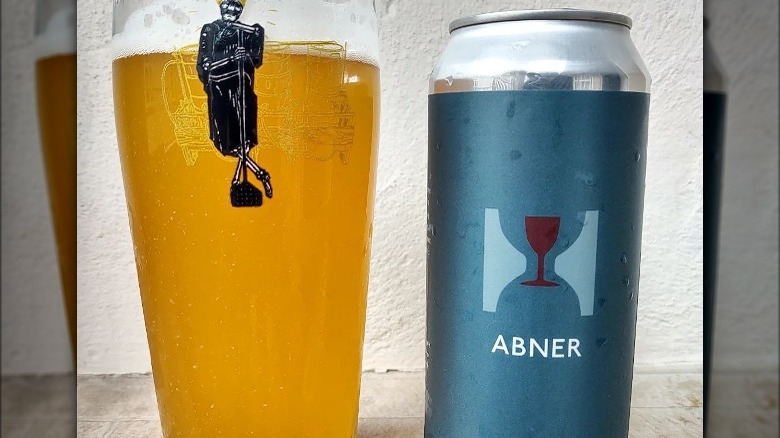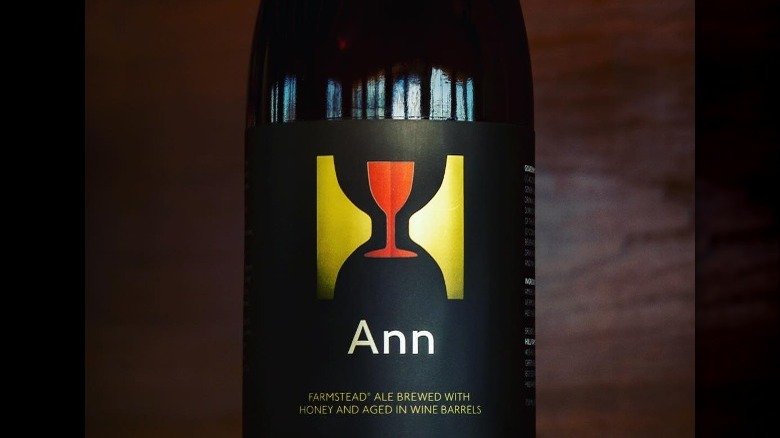20 Best Vermont Craft Beers, Ranked
As the first state to legalize same-sex marriage and recreational marijuana, Vermont is one of the rare progressive states that also happens to be fairly rural. Perhaps because of this unique combination, Vermont is known for being a forward-thinking leader in one particular agriculture-based industry: craft beer. Vermont breweries have been so influential within the U.S. craft beer scene, many people take trips up to Vermont specifically to explore its many influential breweries. According to the legislature in the state of Vermont, Vermont's breweries attract more than 1 million people each year, generating around $130 million.
Although Vermont breweries make a wide variety of beer styles, the state has largely become known for the New England IPA. Defined by a golden color, hazy appearance, and prominent juicy flavor that comes from select hop varieties, the New England IPA style was popularized by iconic Vermont beers like Heady Topper from The Alchemist and Sip of Sunshine from Lawson's Finest Liquids. Thes style has been ubiquitous in Vermont for almost two decades and still largely defines craft beer from Vermont.
But, in recent years, Vermont breweries seem to be looking to turn the page, slowly embracing other styles and subtly shifting away from all things haze. With this backdrop in mind, we've listed some of the best Vermont craft beers you can drink right now.
20. Copper Ale by Otter Creek Brewing
It might be hard to imagine, but there was a lot of really good craft beer being made in Vermont before New England IPAs. Back in the 1990s, malty beers were all the rage, and one of the most popular at the time was Copper Ale from Otter Creek Brewing. The brewery opened in 1991, and at the time, American beer drinkers mostly had a taste for watered-down lagers and pilsners. Easy-drinking Copper Ale wasn't much of a departure from what you could find on the supermarket shelf, and this approachability made it easy for craft-curious consumers to get into.
For many years, the Otter Creek brand was largely in keeping with the approachable, rustic nature of Copper Ale, but in 2014 the company went through a major rebrand. The classic New England imagery was jettisoned in favor of a more fun-loving, bohemian brand. By that time, the brewery had already begun to focus more on hoppy beers, and at some point, it stopped production on Copper Ale. however, all trends go in circles and very recently, the brewery announced it had "dusted off the original recipe" for Copper Ale and started brewing it once again.
If it's been a minute since you had this iconic craft beer, you should know that it still has that nutty aroma and malt-forward taste. These days, it has the added bonus of being American craft beer history in a glass.
19. Double Bag by Long Trail Brewing Company
Nobody bats an eye at a beer over 7% ABV these days, but Seven Days reports that when the brewers at Long Trail came up with Double Bag ale came out in the mid-'90s, co-founder Andy Pherson balked at the idea of marketing a beer with 7.2% ABV. Even though Pherson didn't approve, according to the article, the brewers at Long Trail sold it on the sly in the brewery's taproom where the demand for the not-so-secret beer skyrocketed. It became impossible to deny that Double Bag was a massive hit.
Double Bag is a great example of the altbier style that was all the rage in American craft beer during the '90s. Developed in the German town of Dusseldorf, the altbier style is a type of malt-forward ale that is fermented at relatively cool temperatures; between 60 and 65 degrees F. The result is a copper-colored beer with nutty roasted flavors and mild hop bitterness that has a crisp lager-like finish. Technically speaking, Double Bag is a stronger variation on the style called sticke, or double alt. It has robust bread and caramel flavors that are backed up by a high-alcohol content.
18. Cloud Drop DIPA by Upper Pass Beer Company
If American craft beer has been defined by anything over the past 30 years, it's been breweries going bigger and bolder. Created by adding more hops and increasing the alcohol content of a standard IPA, the double IPA (DIPA) is a perfect example of this recent American mentality toward craft beer. This style was first developed in the mid-'90s, but it wasn't formally recognized by the Great American Beer Festival until 2003.
Today, DIPA is one of the most popular beer styles that you can find at a brewery, and it takes a special version to stand out from the crowd. Cloud Drop DIPA from Upper Pass Beer Company is especially distinctive for its hop profile. A combination of six different hops translates into robust juiciness and a bit of dank resin. There are also flavors of candied orange zest and a bit of hop spice. It's an artful blend of both West Coast and East Coast IPA styles that also happens to be easy to drink, particularly for a DIPA.
17. La Noche Oscura del Alma by Four Quarters Brewing
Brian Eckert had a passion for aging dark beers in large oak barrels long before he opened Four Quarters Brewing and became its head brewer. Accordingly, barrel aging and dark beers have a massive presence at the brewery, which stands out among all the IPA-focused breweries in Vermont. In 2015, just one year after the brewery opened, Eckert told Seven Days that his customers appreciate a focus that isn't hop-obsessed: "I like IPAs, but the hops are in such high demand that it's impossible to get them."
Now that Four Quarters is more established, hops are easier to come by, it seems. The brewery typically has half a dozen or more IPAs on its beer menu. However, barrel-aged and dark beers still very much make up the brewery's offering. Many of these beers take a culinary approach, incorporating ingredients like chocolate and sea salt. To create La Noche Oscura del Alma, the brewery ages an imperial stout in former apple brandy barrels with cacao nibs, chipotle peppers, and cherries. The result is a rich and spicy stout with subtle fruit notes.
16. Madonna by Zero Gravity Craft Brewery
In many ways, the American craft beer industry is defined by the constant push to go bigger and bolder. More hops. Higher ABVs. More nostalgia-baiting additives like breakfast cereals and Hostess snack cakes. So it's refreshing when a brewery like Zero Gravity talks about achieving balance like some Jedi master in a Star Wars prequel. While the brewery does experiment with new techniques and ingredients, it uses them in more of a supporting role than as the lead actor.
That approach from Zero Gravity is on full display with Madonna, the brewery's flagship double IPA. The beer has a body that's on the lighter side for an IPA and it has a relatively high level of carbonation. That lightness truly allows the hops to shine, as they deliver all of the classic New England IPA notes of pineapple, honeydew melon, and grapefruit. Taken together, the lightness and the flavors of this beer do an impeccable job of masking its burly 8% ABV.
15. Pieces of Eight by Foley Brothers Brewing
The term "Pieces of Eight" refers to coins that the Spanish Empire used during its colonial period. Because Pieces of Eight were used from Asia to South America, they are largely considered to be the first global currency. In today's craft beer world, you could argue that hops are the current global currency. Beers, and IPAs in particular, are often valued based on the hops they use.
While it's unclear if Foley Brothers is alluding to this hops-as-currency metaphor with its Pieces of Eight beer, this double IPA is arguably the brewery's most ambitious brew. Made with eight different varieties of hops, this beer has a gigantic hop-forward flavor with mostly citrus and tropical fruit flavors. Hops can also be tasted with a bit of herbal spice and a bold bitter finish. As the beer warms in the glass, the bitter flavors tend to fade while the fruity flavors come to the fore. According to the Foley Brothers, Pieces of Eight has an ABV of 8% and a bitterness rating of 88 IBU, which seems a little too perfect, if you ask us.
14. Experimental Jet Set by Foam Brewers
Many brewers toil in relative obscurity; maybe they get recognized around town or have a loyal following in their region. The folks at Foam Brewers found themselves elevated to the national stage in January 2023 when the brewery was declared a James Beard Award semifinalist in the category for "Outstanding Wine and Other Beverages." This nomination may not have come as much of a surprise to regular Tasting Table readers, who already know it's one of the best places to eat and drink in Burlington, Vermont. Although the brewery didn't make the cut as a finalist for the award, the recognition put it alongside some of the biggest names in the American culinary world.
The nomination also gives added shine to the brewery's many beers, including its Experimental Jet Set Double IPA. This easy-drinking beer does a masterful job of hiding a whopping 9.2% ABV with bushels of tropical fruit and melon flavors. That being said, this isn't a straight-up juice bomb. A bit of dank resin makes this a well-rounded beer worthy of national recognition.
13. Bohemian Pilsner by von Trapp Brewing
The movie clip of Julie Andrews singing and spinning in "The Sound of Music" has been played and parodied so many times, you'd be forgiven for thinking the 1965 movie was a complete work of fiction. But the von Trapp family is actually a real-life family who famously fled their native Austria in the 1930s to escape the Nazi war machine. The family ended up settling in Stowe, Vermont, and opening the Trapp Family Lodge in 1950, a year-round mountain resort where an on-premise brewery was opened in 2010, according to USA Today.
As you might expect, the von Trapp brewery is mostly focused on German beer styles. You also might expect the brewery to mostly be a hospitality operation, a feature of the lodge complex that adds to the overall Austrian vibe. However, von Trapp Brewing is a very serious production operation and many of its beers have won awards, with the Bohemian Pilsner being the most decorated. Crisp, malt-forward, and slightly peppery, this pilsner does what it says on the label and it is a worthy extension of this storied family's legacy.
12. Mosaic IPA by Lost Nation Brewing
Mosaic hops were developed by a fourth-generation hop farmer named Jason Perrault, whose family hop farm covers almost 1,500 acres. Select Botanicals is a hop breeding company based on the farm that has a track record of success. Before the company debuted Mosaic, it also had two other massive hop hits in Simcoe and Citra.
When Perrault started working on Mosaic, PunchDrink says he wasn't trying to create a hop with an entirely new flavor profile, but simply trying to create a version of Simcoe that produced higher yields. Over the course of a decade, the article says that Perrault focused on breeding Simcoe with a strain of Nugget hops, and eventually, the first harvests of Mosaic went to a few select breweries. But the hop became such a hit, hop farmers have struggled to keep up with demand.
These days, many breweries brew beers that exclusively feature Mosaic hops as the only variety in their beer. The Mosaic IPA from Lost Nation is a good example of this approach and it truly lets the dynamic qualities of this hop shine. Yes, it's big and fruity. But, it also has an unexpected vegetal quality that elevates it above the pack.
11. Fair Maiden by Foley Brothers
When Bob and Rhonda Foley bought an inn in Brandon, Vermont in 2006, brewing beer was probably the last thing on their mind. The couple did start Neshobe River Winery, and while they were tending to their vines, the couple's children began taking an interest in brewing. The younger generation of Foleys – Pat, Dan, and Christine — ended up founding Foley Brothers Brewing in 2012.
Named after Christine, Fair Maiden is a double IPA from Foley Brothers that shows how this powerhouse style can have some complexity. As you might expect, this beer ships boatloads of citrus and tropical fruits. But it's the use of malt that makes this beer stand out by perfectly balancing the citrus Tang and slight hop bitterness. While we don't know the inspiration behind Fair Maiden personally, if this beer is any indication, the muse seems like a bold and smart individual that you'll want to hang out with again and again.
10. Second Fiddle by Fiddlehead Brewing Company
While a lot of breweries opening up lately are from people coming right out of homebrewing, Matt Cohen didn't launch his Fiddlehead Brewing Company until working in the industry as a professional brewer, and it's a path he recommends. "(A) lot of these new startups are people who have no experience in the brewing industry," he tells Seven Days. "They're going to make mistakes that are going to jeopardize their companies."
Cohen learned the trade working at Magic Hat Brewing Company and even had a hand in "tweaking" the iconic Magic Hat #9 beer over the years. At Fiddlehead, Cohen's affinity for hoppy beers is laser-focused, and the brewery is known for having long lines of customers waiting for new releases. In 2022, Brewbound named Fiddlehead its Craft Brewery of the Year, citing the brewery's rapid expansion in the marketplace.
Hitting your palate like a pile driver, Second Fiddle delivers a level of complexity rarely seen in double IPAs. This beer is juicy upfront, but the flavor quickly switched to more of a West Coast IPA flavor profile, featuring lots of dank resin. Second Fiddle gets a lot of comparisons to the highly-regarded Sip of Sunshine from Lawson's Finest Liquids, and it's a very fair comparison.
9. Conehead by Zero Gravity Craft Brewery
If you had never eaten a chocolate doughnut before, you would probably be excited by the idea. I like chocolate, you think. I like doughnuts, you think. Putting them together has to be amazing, you might reasonably conclude. But sadly, we all know that chocolate doughnuts are far less than the sum of their parts. Although to be fair, you'll still probably eat a chocolate doughnut if someone puts one in front of you. The same thing goes for wheat IPA beers. On their own, wheat beers and IPAs are two delicious styles of beer, and combining the two forms an unholy, unsatisfying union.
Conehead is an IPA from Zero Gravity that includes wheat as part of its grain bill. But, Zero Gravity also smartly includes pilsner malt, sidestepping the pitfall of producing a wheat IPA. The result is an IPA on the lighter side. The body of this beer is much lighter than the typical modern IPA and the alcohol level is a modest 5.7% ABV. But, what Conehead doesn't have in heft, it more than makes up for in easy-drinking complexity. There is significant juiciness, but Conehead is also dry and refreshing. It's a well-balanced beer in keeping with the very approachable Zero Gravity brand.
8. Mahogany & Tweed by Burlington Beer Company
In recent years, the barrel aging of beers has gone from curiosity to a mainstream brewing technique. Breweries of all sizes aged their beers in barrels to give them deeper flavors and more complexity. When a beer is barrel aged, the liquid absorbs several different compounds from the wood. Lactones can impart floral aromas and flavors. Phenolic aldehydes translate into vanilla flavor on the tongue, while simple sugars provide caramel notes. The beer will also pick up any residual spirits from a barrel that was previously used to age bourbon, cognac, or other spirits. The most popular use of this technique involves aging an imperial stout in bourbon barrels.
Mahogany & Tweed from Burlington Beer Company is a barrel-aged beer that stands out for being a barleywine aged in cognac barrels. With a reddish-brown color and little to no head, this beer is best enjoyed sip by sip. Each taste can reveal something different: robust maple flavors, dried fruit notes, and soft caramel. It's easy to drink for a beer with 12% ABV, so go slow and enjoy.
7. Focal Banger - The Alchemist
If you're ever going to "make it" as a brewer — or as a recording artist for that matter — it helps to have more than one hit. That's the story behind The Alchemist and its Focal Banger IPA. The brewery has a massive hit on its hands with the now-iconic Heady Topper IPA, and when it came time for the brewery to can a second beer, it turned to a muscular IPA on draft in its taproom. Sadly, Focal Banger will always be known as the follow-up act to The Alchemist's Heady Topper, and that's unfortunate because this double IPA explodes with hoppy aromas and flavors. Focal Banger also has a strong yeast component to its flavor profile, which manifests as pleasing bready notes.
While The Alchemist Is known for making two iconic beers, it's also one of the best breweries to visit in the U.S. In particular, The Alchemist has been recognized for its accessibility, earning the Spirit of ADA award from the state government. The brewery not only makes accommodations for customers but also for its employees with different mental and physical abilities.
6. Sip of Sunshine by Lawson's Finest Liquids
The story behind Lawson's Finest Liquids is a story of growing pains: Married couple Sean and Karen Lawson started the company as a passion project, brewing beers on a one-barrel system and mostly selling them at farmers' markets, according to Good Beer Hunting. Over the years, the article says a cult following grew into a massive fanbase, the Lawson's struggling to meet demand, and eventually, the first beer to be released on a wide commercial scale was Sip of Sunshine.
Along with beers from The Alchemist, Sip of Sunshine is helped to define what we now called the New England IPA. Even though it was first released in 2014, Sip of Sunshine still stands out in an ocean of newer, hazy IPAs. As one of the originators of the style, Sip of Sunshine maintains a firm grasp on the craft beer consciousness, and you can taste the influence in every well-balanced, juicy sip.
5. Heady Topper by The Alchemist
During Prohibition, the demand for alcohol outstripped supply by such a degree that people resorted to illegal procurement tactics. Although the government didn't ban Heady Topper IPA from The Alchemist brewpub, the draft-only IPA was so popular, people started bottling pints of it in the bathroom. In 2013, a woman was arrested for trying to sell a case of Heady Topper for more than $700, a tenfold markup, according to Longreads.
Heady Topper has long since been canned and distributed regularly. These days, it's hard to imagine the rabid hype swirling around this IPA, so it's important to remember that this beer inspired an entire genre of beer. It's also important to note that Heady Topper still stands up as a great beer. Many breweries have taken the "juicy IPA" in a more extreme direction, but Heady Topper remains as a well-balanced, hop-forward brew supported by a solid malt backbone and proprietary yeast strain.
4. Lush by Frost Beer Works
When he first started brewing, Garin Frost was focused on making German-style beers because those were the styles he was drinking at the time, according to Seven Daily. Then, Frost got into IPAs. Timing, as they say, is everything because the brewery Frost wound up opening — Frost Beer Works — has become one of Vermont's most heralded IPA-focused breweries. Considering that Frost is putting its beers alongside iconic brews from The Alchemist and Lawson's Finest Liquids, it says something that Frost beers have become emblematic of the style.
Rather than try to reinvent New England IPAs, Frost is focused on making incremental but noteworthy tweaks — and people are paying attention. The brewery regularly scores high on blind tastings alongside highly celebrated hazy IPAs. Lush combines hot varieties from both the Northern and Southern hemispheres to create a complex flavor profile that blends fruit and pine-y dankness.
This beer isn't a hop bomb, but it scores big for balance and complexity. Bottom line: This flagship beer from an IPA-focused brewery is one of the more complex double IPAs you'll find on the market.
3. Purple Dot by House of Fermentology
Brewmaster Todd Haire is probably best known for his work with Foam Brewers, and while that brewery has earned national recognition, Haire also finds time for Foam's wild ale-focused sister brewery: House of Fermentation. Together with friend and author Bill Mares, Haire uses House of Fermentology to focus on boundary-pushing barrel-aged beers fermented with wild-strain yeasts. These beers start as wort brewed offsite that is then fermented — occasionally with fruit — in oak barrels with Saccharomyces and Brettanomyces yeasts. Each release is named with the word "dot" because all starts "starts with a single dot," Haire told Hop Culture.
For Purple Dot, the brewery blended barrel-aged sour ale and fermented the blend on black currants and blackberries. It was then bottle-conditioned with raw Vermont honey. The result is a super tangy beer that keeps strong sourness in check with a crisp dry finish. There's also a bit of spice and fruit in the proceedings, making this a highly complex brew.
2. Abner by Hill Farmstead
Before he created Hill Farmstead Brewery, Shaun Hill cut his teeth working for a Danish brewery where experimentation was expected, which pushed Hill to embrace big and complex beers. Several medal-winning beers at the World Beer Cup are said to have convinced Hill his experiments were good enough to go professional.
At Hill Farmstead, the eponymous brewer both doggedly chases his experimental muse and pays tribute to those that came before him, specifically the seven generations of Hills who had lived on the land where the farmhouse brewery sits. Named after Hill's great-grandfather, Abner is the brewery's second release and its complexity is indicative of the brewery as a whole.
Abner is a double dry-hopped IPA made with "a plethora" of American hops. However, the is a very restrained beer that allows soft melon notes to intermingle with piney resin. Made the water from "Abner's well" this beer is also a loving tribute to a long-passed family member.
1. Ann by Hill Farmstead
In addition to being inspired by an experimental approach to brewing, Shaun Hill is also fascinated by Eastern philosophy and self-examination. Hill may have left behind a philosophy major at Haverford College when he became a brewer, but he tells NewEngland.com that he has made philosophy an integral part of his brewery.
This is on full display in the website's description of Ann, a barrel-aged version of its Anna farmhouse ale that's brewed with honey. Less than 10% of all barrel-aged Anna becomes Ann, and these barrels are chosen based on an "emotional response" that occurs during the tasting. According to the website, the "beer, the barrel, and some yet unknown, unquantifiable condition" are responsible for the end product, while wine barrels continue "the evolution of Anna into Ann is an indeterminate and metamorphic occurrence."
Sure, all that sounds great, but what does Ann taste like? As you might expect, it's an elegant farmhouse ale that balances the poetry of floral honey with the thunder of barnyard funk. The wine barrel aging presents itself with minerality and hints of oak. Whether or not you appreciate the philosophy behind it, Ann is a work of art.
